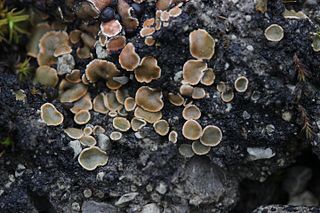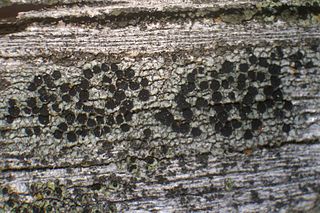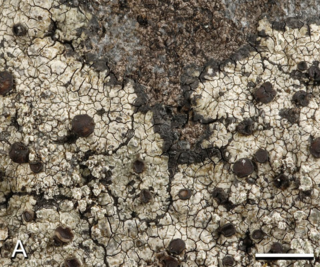
Psora is a genus of lichen-forming fungi in the family Psoraceae. Members of the genus are commonly called fishscale lichens. Lichens in the genus Psora generally have a squamulose thallus and anthraquinones in the hymenium. Photobiont partners of Psora lichens include members of the green algal genera Asterochloris, Chloroidium, Myrmecia, and Trebouxia.

Buellia is a genus of mostly lichen-forming fungi in the family Caliciaceae. The fungi are usually part of a crustose lichen. In this case, the lichen species is given the same name as the fungus. But members may also grow as parasites on lichens (lichenicolous). The algae in the lichen is always a member of the genus Trebouxia.

Roccella is a genus of 23 species of lichens in the family Roccellaceae. The genus was circumscribed by Swiss botanist Augustin Pyramus de Candolle in 1805, with Roccella fuciformis as the type species.

Calvitimela is a lichen genus in the family Tephromelataceae. Members of the family Tephromelataceae are crustose lichens with green photobionts and lecideine or lecanorine apothecia. The species in Calvitimela have lecideine apothecia, are saxicolous and are primarily found in alpine to arctic regions.

The Lecideaceae are a family of lichen-forming fungi in the order Lecideales. It contains about 30 genera and roughly 250 species. A major distinguishing characteristic of the family is the lecanoroid form of the fruiting bodies: typically circular, dark, and without a thalline margin. Most species in the family are lichenised with green algae, although a few species, scattered amongst several genera, are lichenicolous—they live on other lichens. Lecideaceae lichens tend to grow on rocks, wood, and soil. Several Lecideaceae species accelerate the weathering of rock surfaces, a process known as pedogenesis, by extending their hyphae into cracks and expelling rock flakes. This contributes to significantly faster weathering rates in certain environments, impacts various materials from natural rocks to man-made Sekishu roof tiles, and involves key biomolecules identified for survival and biodeterioration, including compounds to withstand intense ultraviolet radiation.
Teuvoa is a genus of lichen-forming fungi in the family Megasporaceae. It was first classified by lichenologists Mohammad Sohrabi and Steven Leavitt in 2013, with Teuvoa uxoris asigned as the type species. This genus was delineated from the larger genus, Aspicilia, following a molecular phylogenetic analysis which revealed that the Aspicilia uxoris species group constituted a distinct lineage in the Megasporaceae. Initially containing three species, two additional species native to China were added in 2018. Teuvoa is characterised by its small ascospores and conidia, and the absence of secondary metabolites.
Buellia peregrina is a species of saxicolous (rock-dwelling), crustose lichen in the family Caliciaceae. It is found in the Namib desert in Namibia.
Upretia is a genus of lichen-forming fungi in the family Teloschistaceae. It has three species of saxicolous (rock-dwelling), crustose lichens. Upretia is characterised by its small ascospores and narrow, rod-shaped conidia. The distribution of the genus ranges from mid-altitude rocky terrains in India to both arid and higher altitudinal environments in China.
Lecidea lygommella is a species of saxicolous (rock-dwelling), crustose lichen in the family Lecideaceae. It spreads up to 7 cm wide with a thin thallus varying in colour from whitish and pale grey to rusty red-brown, featuring areolate surfaces with irregularly shaped areoles. Its fruiting bodies range from slightly embedded to sitting atop the thallus and black, flat to slightly convex apothecial discs. Unlike its lookalike Lecidea lygomma, L. lygommella does not produce any secondary chemicals. It is found in New South Wales and Victoria, Australia, where it grows on rocks in alpine areas.
Placolecis kunmingensis is a species of saxicolous (rock-dwelling), crustose lichen in the family Catillariaceae. It is found in Yunnan, China. The lichen is characterised by a thallus that is areolate to squamulose in its centre, forming irregular patches or clumps 10–50 mm wide, as well as its ellipsoid or spherical ascospores with slightly thickened wall.
Upretia squamulosa is a species of saxicolous (rock-dwelling), squamulose (scaly) lichen in the family Teloschistaceae. It was identified as a new species in 2019 from specimens collected in the arid valley of the Jinsha River in Yunnan, China.
Buellia phillipensis is a little-known species of saxicolous (rock-dwelling), crustose lichen in the family Caliciaceae, described in 2020. It is only known to occur on Phillip Island in the Southwest Pacific.
Amandinea pilbarensis is a little-known species of crustose lichen in the family Physciaceae, First described in 2020, it is found in Australia. It is similar to Amandinea polyxanthonica, but can be distinguished by its smaller ascospores and the presence of calcium oxalate and thiophanic acid in the medulla.

Flavoplaca oasis is a species of saxicolous (rock-dwelling), crustose lichen in the family Teloschistaceae. It is widely distributed across Europe, and has been reported in Western Asia, China, and North Africa.
Oxneriopsis is a genus of lichen-forming fungi in the family Teloschistaceae. It has four species of corticolous (bark-dwelling), crustose lichens.
Nitidochapsa is a genus of lichen-forming fungi in the family Graphidaceae. It has five species of corticolous (bark-dwelling), crustose lichens.

Glaucomaria is a genus of lichen-forming fungi in the family Lecanoraceae. It has seven species. The genus was circumscribed by Maurice Choisy in 1929. It contains crustose lichens formerly placed in the Lecanora rupicola species complex as defined by several previous authors.
Yoshimuria is a genus of lichen-forming fungi in the family Teloschistaceae. It has four species of crustose lichens.
Buellia subalbula is a species of saxicolous (rock-dwelling), crustose lichen in the family Caliciaceae. It occurs in coastal southern Africa, South America, and Australia, where it grows on calcareous rocks.

Sucioplaca is a single-species fungal genus in the family Teloschistaceae. It contains Sucioplaca diplacia, a saxicolous (rock-dwelling) crustose lichen. It is common and widely distributed in the Caribbean, Central America, and the Galápagos Islands, where it grows on coastal rocks.








